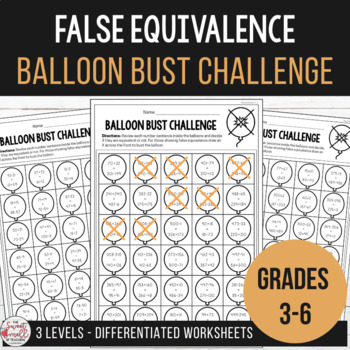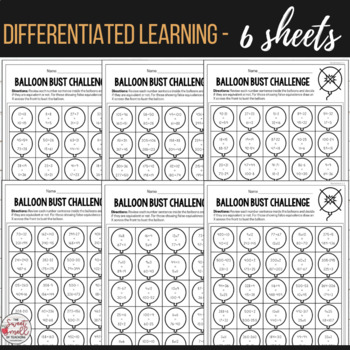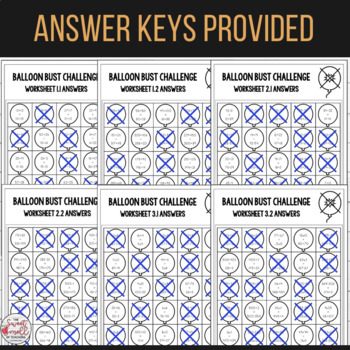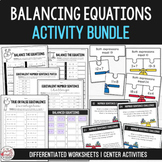False Equivalence Balloon Bust Challenge - Differentiated Worksheets
- Zip
Also included in
- Balance the Equation - Equivalent Number Sentence BundleFor students to effectively progress from arithmetic to algebraic thinking, they must understand equivalence. Unfortunately, there are many students who do not understand the meaning of the equal sign and thereby experience problems interPrice $20.12Original Price $25.15Save $5.03
- Balancing Equations Digital & Print Mega BundleFor students to effectively progress from arithmetic to algebraic thinking, they must understand equivalence. Unfortunately, there are many students who do not understand the meaning of the equal sign and thereby experience problems interpretiPrice $37.15Original Price $49.55Save $12.40
- Balance the Equation - Equivalent Number Sentence Worksheet BundleFor students to effectively progress from arithmetic to algebraic thinking, they must understand equivalence. Unfortunately, there are many students who do not understand the meaning of the equal sign and thereby experience problePrice $13.63Original Price $15.15Save $1.52
Description
False Equivalence Balloon Bust Challenge - Differentiated Worksheets
For students to effectively progress from arithmetic to algebraic thinking, they must understand equivalence. Unfortunately, there are many students who do not understand the meaning of the equal sign and thereby experience problems interpreting, modifying, and answering equations, specifically those that incorporate multiple numerical terms.
Equivalence activities can also be used to develop student's relational thinking.
This resource is also available in a bundle:
• Balance the Equation - Equivalent Number Sentence Bundle
This product includes:
- 6 worksheets
- 6 answer keys
- Resource instructions
Students will use their problem-solving skills to review equivalent number sentences involving addition, subtraction, multiplication and division.
Students are asked to investigate each number sentence found inside the balloons. The goal of the activity will be to identify the equivalent number sentences showing false equivalence and draw an X across the front to bust the balloon.
This resource is also available in a bundle:
• Balance the Equation - Equivalent Number Sentence Bundle
Differentiated Learning Activities
Activities become progressively harder as students proceed through each worksheet. Advanced students will move through to level 3 worksheets. Those experiencing difficulties may remain on level 1 worksheets to practice the basic concepts involved with equivalent number sentences.
*Updated to Version 2 in December 2019. Now includes new design and 5 additional worksheets*
Level 1
Worksheet 1.1: Equivalent number sentences involving addition within 100.
Worksheet 1.2: Equivalent number sentences involving addition within 500.
Level 2
Worksheet 2.1: Equivalent number sentences involving addition and subtraction within 100.
Worksheet 2.2: Equivalent number sentences involving addition and subtraction within 500.
Level 3
Worksheet 3.1: Equivalent number sentences involving addition, subtraction, multiplication and division within 100.
Worksheet 3.2: Equivalent number sentences involving addition, subtraction, multiplication and division within 500.
Looking for more resources involving balancing equations? You may also be interested in:
• Balance the Equations - True or False Equivalence Challenge Cards
• Balancing Equations - Equivalent Number Sentence Challenge Sheets
• Balancing Equations - Equivalent Number Sentence Activities
• Balancing the Equation - Equivalent Number Sentence Match
• Balancing Equations True or False Equivalence Investigation Sheets
• Balance the Equation - Equivalent Number Sentence Jigsaw Activity
If you like this product, you may also be interested in these resources:
Operations & Algebraic Thinking
• Growing & Shrinking Number Patterns - Challenge Sheets
• Multiplication Games - Memory Cards
Number & Operations in Base Ten
• Rounding Numbers - Task Card Activities
• Addition & Subtraction with Regrouping Activities
• Addition & Subtraction with Regrouping Activities - Back to School Edition
• Comparing Numbers Worksheets
• True or False Comparing Numbers Challenge Cards
Number & Operations - Fractions
• Comparing Fractions, Decimals & Percents - Comparison Cards & Worksheets
• Fraction and Decimal Games - Memory Cards
Measurement & Data
• Metric Measurement Conversions - True or False Challenge Cards







